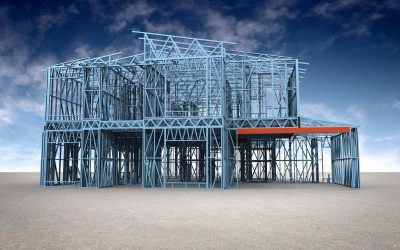DfMA: Why Manufacturing Is the Key to Viability — Blog 4: New Principles for Scalability
In my previous blog, I discussed the rise and fall of Katerra and presented several observations about what went wrong. For this fourth installment of my blog series about design for manufacturing and assembly (DfMA), I’m focusing on new ideas and proven principles that could help future DfMA startups to launch and scale.
- Blog Post
- June 2023

- Pekka Moilanen
- Marketing Director
As I see it, there are five key principles that will significantly affect the viability of future DfMA ventures:
- Sustainable economics
- Ecosystems vs. Monolithic Approaches
- Multi-level Alignment of Design and Manufacturing
- Design and Process Automation
- Execution
Let’s begin with the basic economic principles of supply and demand.
Sustainable Economics
Perhaps the most glaring lesson to be learned from Katerra is that no amount of funding can make a startup (in DfMA or otherwise) immune from the laws of supply and demand. In the case of Katerra, $2 billion wasn’t enough to buy enough demand to scale the company into commercial viability.
Katerra’s objective was to integrate technology, design, and manufacturing to reduce costs and accelerate the construction process. It seems that the overall goal was to provide additional value to project owners and end-users through the development of a novel, efficient, and integrated one-stop-shop approach to construction — but it’s clear that they fell short.
While the company spent millions on strategic acquisitions to bring new design and construction capabilities into their operation and built state-of-the-art facilities, there is little evidence that these acquisitions added any value to Katerra’s end products. There were reports of cost overruns and delays affecting many of Katerra’s projects — neither of which are indicative of a tightly integrated organization.
As one report pointed out, “Katerra chose to build its own supply chain at great expense and, in the end, it delivered no competitive advantage.” With no value added to the end product in terms of cost savings, quality, or schedule, there was no incentive for project owners and financiers to accept the risks associated with a new approach to construction.
In the end, Katerra was unsuccessful in generating a pipeline of work to sustain the company’s growth. It’s telling that many of Katerra’s assets in in the U.S. were acquired by Volumetric Building Companies (VBC), a company specializing in high-density modular construction that already had a market-driven demand in place. VBC didn’t need Katerra’s assets to cultivate demand. Rather, the company needed Katerra’s production to satisfy demand that was already established.
Ecosystems
The area comprised of Finland, Norway, and Sweden is one of the global strongholds of industrialized construction, and in a 2023 presentation to the Oregon Mass Timber Network, Helena Lidelow explained why.
These countries have an advanced ecosystem of specialized companies focused on the many different aspects of industrialized construction and DfMA. There are numerous factories and production facilities, module suppliers, machine manufacturers, automation providers, software companies, logistics providers, engineers, product developers, and more.
The incredible bandwidth of capabilities offered by this rich network of companies is core to the success of DfMA in northern Europe, and it also serves as an incubator for new startups in the region.
Katerra was criticized for doing too much at once and effectively trying to boil the ocean, so to speak, but in hindsight we can see that the company was trying to stand up an ecosystem on par with those that can be found in countries where DfMA is already flourishing. The U.S. lacks the industrialized construction infrastructure and workforce found in those countries, so Katerra tried to buy it.
This is an example of the so-called chicken-and-egg problem: The ecosystem of industrial construction companies won’t exist in the U.S. market until several companies can scale, and those same companies will need an ecosystem of partners to grow, gain market share, and scale.
It’s possible that a different investment strategy might yield a better outcome. Instead of pouring billions of dollars into a single company, what if funds could be invested into an incubator model, where a handful of good concepts could be funded to effectively seed the next generation of DfMA startups?
I think the best path forward would be to focus on building ecosystems rather than large, monolithic companies that will face the same headwinds that held back Katerra.
Multi-level Alignment of Design and Manufacturing
The alignment between design and manufacturing is a core tenant of DfMA. To achieve an economy of scale, it’s necessary for the architects designing a building to work closely with their counterparts in the factory where the building components will be produced.
In response to my previous blog, @Glenn Ford, former Vice President of VBC, commented that while the concept behind DfMA is simple, successful implementation can be a long journey. The key to success, according to Mr. Ford, is “collaborative communication flow between the shop floor (the lab) and the architect (designers)/shops engineers (the theory).”
In Mr. Ford’s view, success is defined as the elimination of wasted time during the manufacturing process, and it is ultimately contingent upon real, two-way communication between the architects and shop engineers.
I think Mr. Ford’s assessment is correct and also provides some clues into tangible steps that can be taken to ensure the lines of communication are open.
Initially, it’s important for building designers to know what they don’t know, meaning that before the inception of the design process, they need to understand the specifications and tolerances of what components can be manufactured at each facility under consideration and how those tolerances will affect the design process.
Transportation constraints and permitting issues should also be considered well in advance of design.
I would argue that these initial engagements should occur independently and in advance of any particular project.
At the project level, deliberate engagement between the building design team and the factory engineers cannot be an afterthought. The parties should maintain a dialogue from the initial design discussions through the development and approval of shop drawings to ensure that the components being fabricated align with the overall design and that both teams are on the same page.
As projects move forward, it’s critical for the design, construction, and manufacturing teams to remain tightly coordinated to ensure that all aspects of the project are in sync.
Design and Process Automation
While the construction industry lags behind other sectors in technology adoption and digital transformation, investors are optimistic about the industry’s growth potential.
In 2021, a record $4.5 billion was invested into construction technology startups. These companies have the potential to become the foundation of a new movement toward industrialized construction.
On the design side, building information modeling (BIM) software can greatly accelerate and improve communication and coordination between architects, factory engineers, and contractors.
Vertex BD, for example, translates essential project information across all the disciplines involved in producing modules and panels for off-site construction. Our software can generate complete architectural drawings, shop/fabrication drawings, material reports, and manufacturing data from a single building model.
Production also stands to gain a great deal from new technologies, as innovations such as advances in robotics, process automation software, and 3D printing will increase returns on capital investments.
Embracing emerging construction technologies will enable the production facilities of the future to maximize productivity, further widening the efficiency gap between off-site and traditional construction.
Execution and Sound Management Are Still Critical
While technology will surely transform construction in the coming years, there is one axiom that I am sure will not change: Construction is about execution — finishing projects on time and within budget.
As Katerra attempted to build its own DfMA ecosystem, its performance in the field suffered. The company’s scheduling, quality control, and management challenges were significant enough to cause problems for any construction company — site built, DfMA, or otherwise.
The takeaway here is that execution is still the top priority in the construction business, and successful execution results from sound leadership, strong management, and efficient processes that are understood and correctly implemented at all levels of the organization.
DfMA Has Staying Power for a Reason
DfMA isn’t a new idea. It’s been around for decades. And while this approach still trails site-built construction in many markets, its staying power is a testament to the market forces that make it an increasingly attractive option.
Labor and materials will continue to increase in cost and scarcity, and site conditions will continue to be adversely affected by rain, snow, and all the other elements that make on-site construction riskier than manufacturing in a controlled setting.
I’m confident that the principles discussed here would be integral to ensuring the continued growth of DfMA, and I would love to hear your assessment.
Stay tuned for my next blog, where I’ll discuss the big developments I see on the horizon for DfMA.
Related Stories
Cold-formed steel design-to-factory automation with Vertex BD
To fully realize the benefits of offsite manufacturing and modular construction, companies need a digital workflow that links the design office directly to fabrication.
Why Vertex is the leading CAD construction software
Best 3D construction software for professionals The construction industry is evolving rapidly, with factory-built construction gaining popularity due to its efficiency and precision. Companies that manufacture building components - such as walls, floors, and entire...
Best 3D construction software for professionals
Best 3D construction software for professionals 3D construction software has become a cornerstone of modern building projects, fundamentally transforming traditional construction practices. By enabling architects, engineers, and builders to create highly detailed,...




